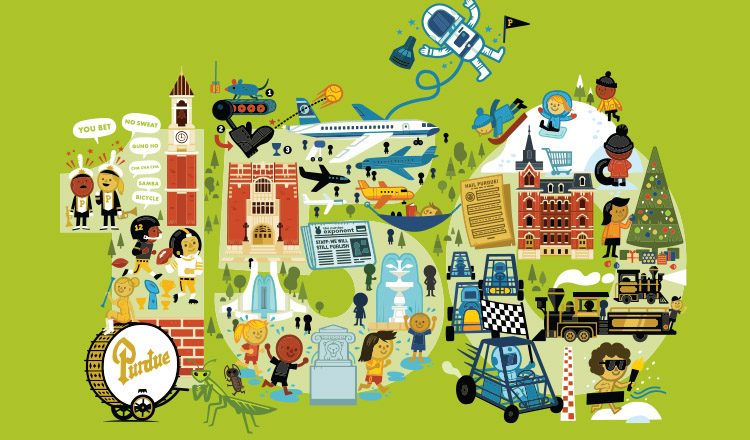Ways Boilermakers show school spirit
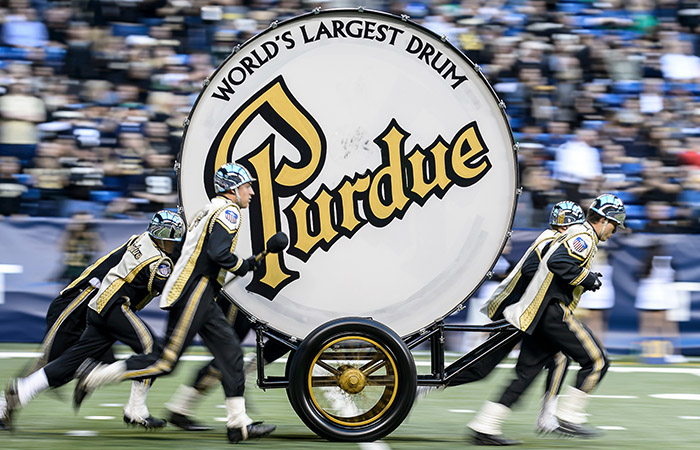
1. Big Bass Drum
Introduced in 1921 and requiring six people to operate, the Big Bass Drum is the largest freestanding bass drum in the world. When it was built in Elkhart, Indiana, it easily doubled the size of any drum in the world. Today, the inside of the drum’s shell bears the signature of every band member who has served on the drum crew during its time in service.
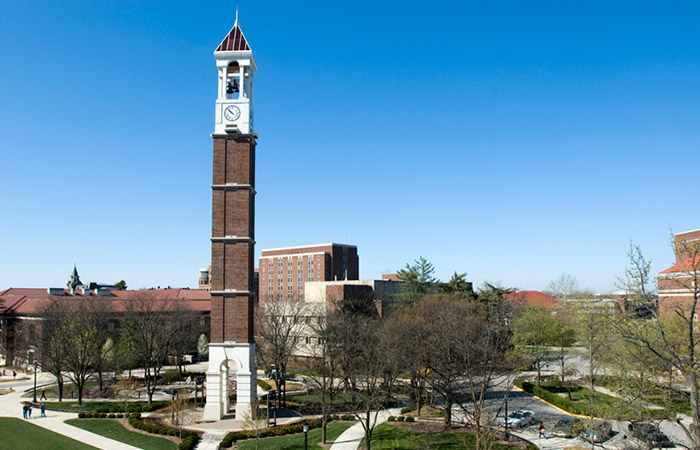
2. Bell Tower playing “Hail Purdue”
Soaring over the center of campus, the Bell Tower was funded by the class of 1948 and built in 1995. It is equipped with an electronic carillon that plays “Hail Purdue” at various times throughout the day. The carillon has a large inventory of songs that can be programmed for special events, including “Oh, What a Beautiful Mornin’,” “Hey Jude,” “Bingo,” “For the Honor of Old Purdue,” and “(Back Home Again in) Indiana.”
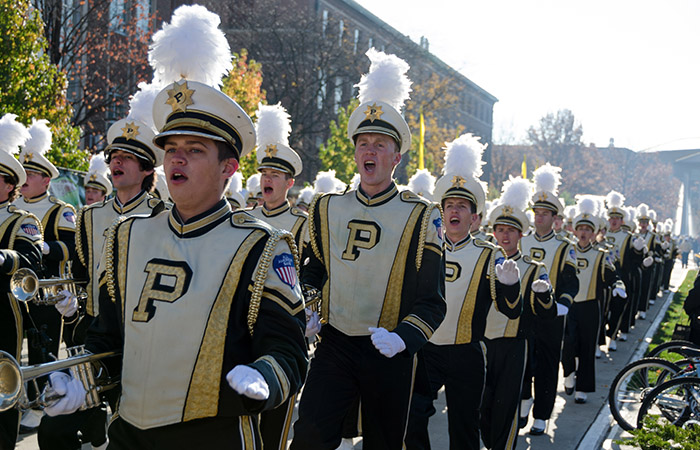
3. Band Cheer
What do butter, Snoopy, and Roy all have in common? They’re all part of the “All-American” Marching Band’s constantly evolving cheer, written to commemorate special moments in Purdue’s history. In this case, butter is a reference to the 1979 Houston Bluebonnet Bowl; Snoopy gives a nod to the 2010 Macy’s Thanksgiving Day Parade, where the band marched with Snoopy right behind it; and Roy pays tribute to Roy Johnson for 60 years of dedication to Purdue.
The cheer: Hell yes, damn right! You bet. No sweat. Gung ho. Cha-cha-cha. Samba. Bicycle. Cerveza. Scooby Dooby Doo. Roses. Yup. Bufori. El baño. Smax. Howaya. Peaches. Reerr. Butter. Ciao. Bush. Chingay. Sudler. Alamo. FISS. Coach. Jing. Snoopy. Apollo. Sláinte. Flores. Roy. Awesome.
4. “Hail Purdue”
The official fight song of Purdue University, “Hail Purdue” may very well be the nicest school fight song around. Not only is it devoid of words like go, fight, or win, it speaks of friendship, loyalty, gratitude, and fond memories. James Morrison (-S’1915) penned the words to “Hail Purdue” in 1912 while he was still a student. He originally titled it “Purdue War Song,” but it was changed to “Hail Purdue” when it was copyrighted in 1913. Morrison collaborated with Edward Wotawa (S’1912), a former Glee Club member, who put the words to the music we all know and love!
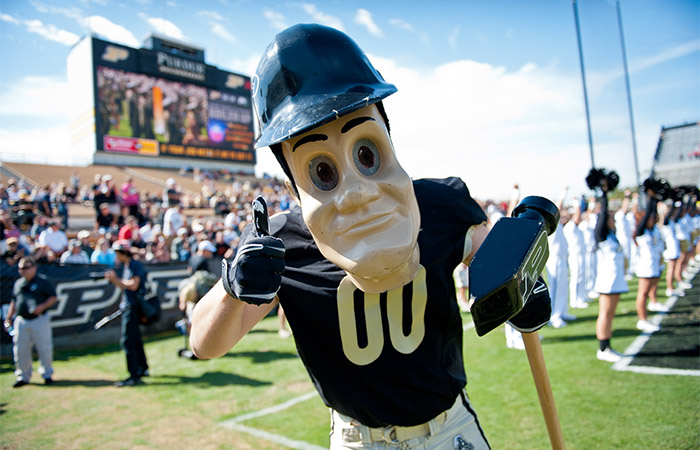
5. Purdue Pete
Each year, about a half-dozen people are selected to join the proud ranks of Purdue Pete mascots dating back to Larry Brumbaugh (ME’57), the first to play Pete in September 1956. Multiple transformations have met with varying levels of fan approval, some even accused of being too frightening for children. Through it all, Purdue Pete has remained a beloved figure on campus as Purdue’s sports mascot.
6. Boiler Up
Boiler Up quickly caught on as a favorite axiom of Purdue fans after Arnette Tiller, wife of head football coach Joe Tiller, introduced it early in her husband’s tenure in an attempt to bring more enthusiasm to Ross-Ade Stadium. The phrase even found its way (unofficially) into the school fight song. At the time, Tiller was unaware that in the days of steam-powered locomotives, the fireman would exclaim “Boiler’s up!” when he got the fire in the coal box hot enough for the engine to run.
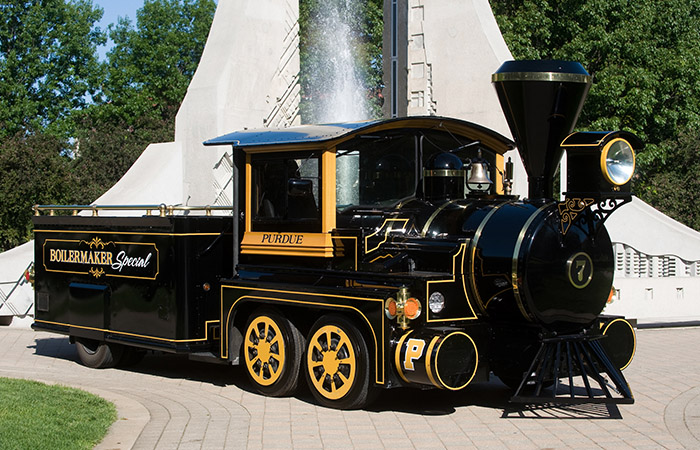
7. Boilermaker Special
How many schools have mascots that weigh in at 6.5 tons, boast five air horns, and thunder down the interstate at 75 mph? Maintained by the Reamers, the Victorian-era locomotive is considered to be the world’s largest, loudest, and fastest collegiate mascot. Purdue’s beloved mascot dates back to 1939 when Izzy Selkowitz (P’41) wrote the school paper, arguing in favor of a mascot that would reflect Purdue’s engineering heritage. A year later, the idea came to fruition as the Boilermaker Special I. The Reamers have been its caretakers ever since.
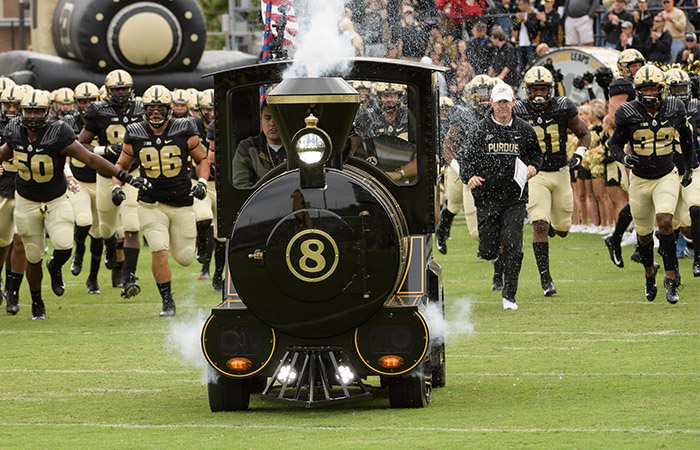
8. Boilermaker Xtra Special
The Boilermaker Xtra Special VIII, dedicated in October 2017, is the second rendition of the smaller train. The April 1978 issue of Purdue Alumnus included a story by Robert Geiger (A’78, MS M’88) appealing to alumni to contribute ideas or building materials for the construction of a miniature version of the Boilermaker Special that would be powered by an electric motor, allowing it to maneuver indoors and in tight spaces that prohibited the larger, heavier train. The Xtra Special now leads the football team onto the field during every home game.
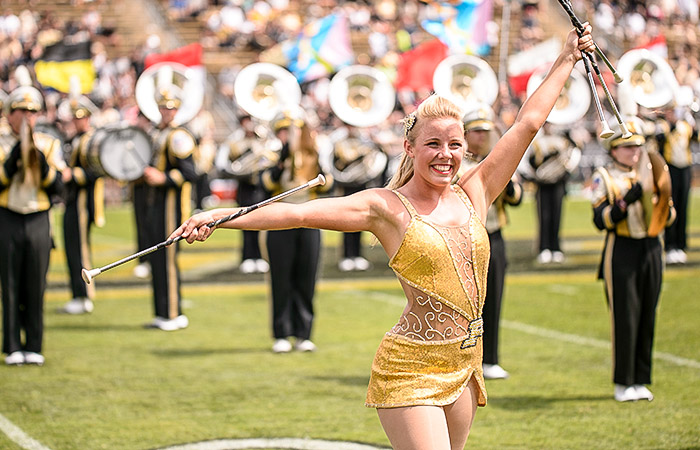
9. Golden Girl
Al Wright, director of bands, recruited dazzling twirler Juanita Carpenter (-S’58) to attend Purdue in 1954 and perform in front of the “All-American” Marching Band on the field. Carpenter’s sequined costume, which boasted a high neck and a skirt, shocked some in Ross-Ade Stadium who were accustomed to majorettes performing in slacks and long-sleeved jackets. Wright’s wife, Gladys, suggested the position be dubbed Golden Girl after star quarterback Len Dawson (HHS’67), who was nicknamed Golden Boy in the press.
10. Old Gold and Black
Shortly after Purdue opened its doors, there was a nationwide move for universities to distinguish themselves through school colors. At the time, Princeton boasted the nation’s best football team. In an effort to boost Purdue’s visibility and tie the school to a successful football program, it was determined that Purdue should copy Princeton’s colors: orange and black. The players didn’t care for it, so they modified the colors to what we know today: old gold and black.
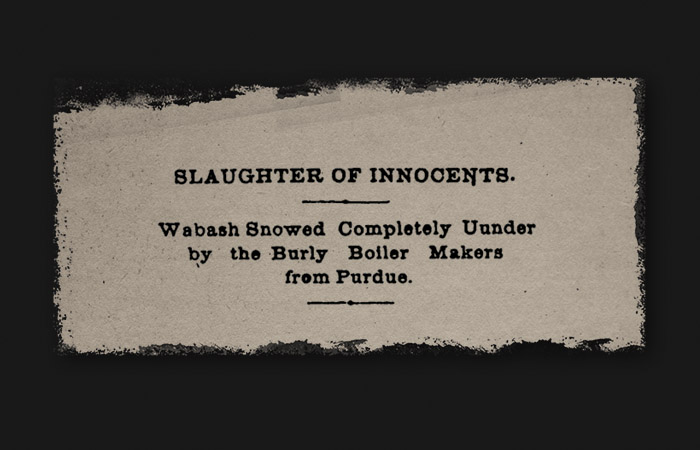
So where did the name BOILERMAKER actually come from?
Purdue fielded its first football team in 1887, losing its only game to Butler 48–6. By 1891, the University had hired two coaches from eastern power Princeton and was on the verge of an era of total domination. In the 1891 season opener, Purdue traveled to Wabash College in nearby Crawfordsville, Indiana. Besides coming away with a 44–0 victory, the Purdue “eleven,” as football teams were known back then, earned a new nickname.
In the 1890s, hometown newspapers were considerably more protective of college teams than they are today. After the 44–0 drubbing, one Crawfordsville newspaper lashed out at the “Herculean wearers of the black and old gold.” Beneath the headline “Slaughter of Innocents,” the paper told of the injustice visited upon the “light though plucky” Wabash squad.
By the next week, the Lafayette papers were returning the taunts: “As everyone knows, Purdue went down to Wabash last Saturday and defeated their eleven. The Crawfordsville papers have not yet gotten over it. The only recourse they have is to claim that we beat their ‘scientific’ men by brute force. Our players are characterized as ‘coal heavers,’ ‘boiler makers’ and ‘stevedores,’” wrote a reporter for the Lafayette Sunday Times on November 1, 1891.
The nickname stemmed from the nature of a Purdue education. As a land-grant institution since its founding in 1869, the college had schooled the sons and daughters of the working class for occupations that were considered beneath the high-born who attended liberal arts colleges such as Wabash.
That same fall of 1891, Purdue had acquired a working railroad engine to mount in a newly established locomotive laboratory. It was one more step in the development of Purdue as one of the world’s leaders in engineering teaching and research. For athletic adversaries and their boosters, this specialty in engineering education — and the other concentration at the founding of the institution, agriculture — served as fodder for name-calling.
Over the years, Purdue teams had been called grangers, pumpkin-shuckers, railsplitters, haymakers, cornfield sailors, blacksmiths, foundry hands, and finally, boilermakers. That last one stuck.

